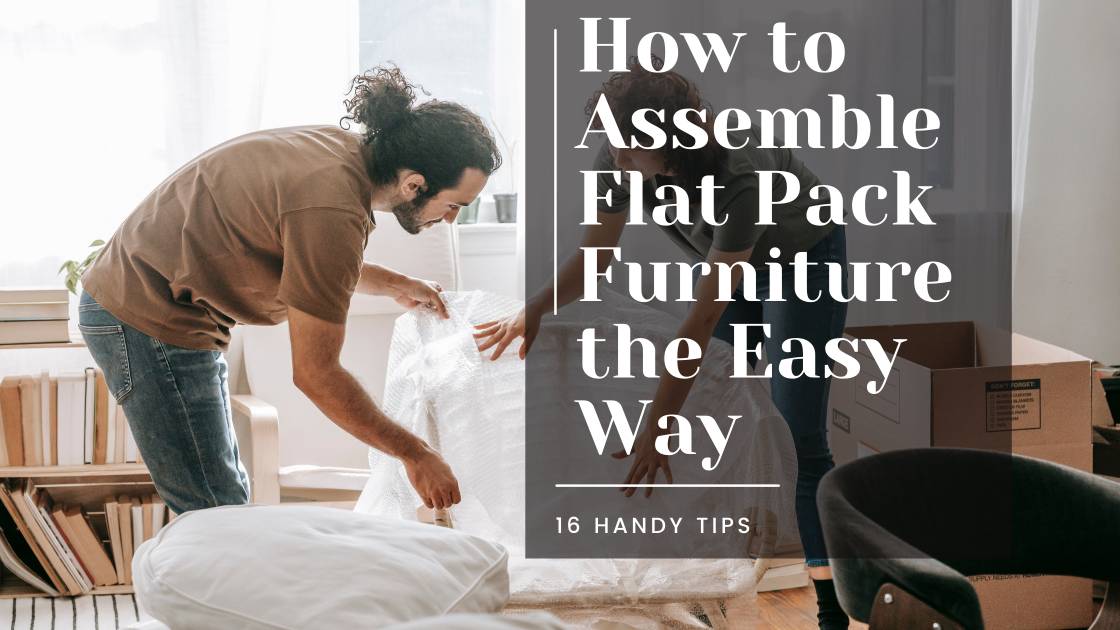
Not everyone is a do-it-yourselfer. In my life, I’ve put together a fair amount of flat-pack furniture. From Kid’s bunk beds to shelves and cabinets, I’m used to assembling bits and pieces into something bigger, but no matter your experience, it can be a daunting task. DIY isn’t always easy, but with the correct equipment, patience, and knowledge, it can be done!
We’ve compiled a list of our best tips for assembling flat-pack furniture to help those who need it the most!
I’ve done this myself, and it’s such an avoidable mistake! Before purchasing an item, make sure the measurements match the space you have. Look for goods that will best fit in your space.
Check out the following guides for creating stunning bedrooms in a small space.
Make sure you make extra room before assembling your furniture. It’s best to assemble the furniture in the room where it’s going to be used and near the area where it will be used.
Remove all the parts and all the bits and pieces and place them on the floor. If you are on a carpet, utilise the box it came in or put a bed sheet down. Put small things like screws in plastic containers. There’s nothing more irritating than losing screws in the carpet pile!
Keep children out of the room to protect their safety and to reduce your stress levels!
They want to help, and that’s great, but do yourself a favour and keep your kids away.
You don’t want them getting splinters or standing on a screw!
Make sure the space is well-lit, so you can see what you’re doing – use all the available light you can. Open curtains or blinds, turn on lights and use any bright lamps to light the room as much as possible.
Some items can contain hundreds of parts, so take the time to double-check that all parts and fixings are in good order. Some parts may have been damaged during storage and shipping.
Make certain that nothing is missing; nothing is more frustrating than learning that a screw or two is missing halfway through. In most cases, the instructions provide a numbered checklist.
It is a good idea not to throw away the packaging until you have double-checked that you have all the necessary parts and accessories.
When something appears to be missing, check the package to see if they are stuck in a corner somewhere and check to see if any spare parts are available. Some flat pack furniture comes with extras.
Don’t be overly concerned if certain components of the shipment are missing; it’s disappointing, but it happens. Most companies can supply replacements for lost or damaged parts of their merchandise. Contact the store to request replacements.
The majority of ready-to-assemble furniture comes with the necessary tools for assembly. However, when working with more complex items, you may need to gather the essential tools before beginning the project. An adjustable spanner, hammer, rubber mallet, Allen keys, Sandpaper, spirit level and a set of Phillips screwdrivers help with furniture construction.
Using a power tool, such as an electric screwdriver or drill with interchangeable bits, can simplify the process.
Most people skip this step, but if you read the instructions carefully, you will have a clear understanding of the process, which will make things easier in the long run. If you rush through each step and skip sections, you will create mistakes that will be difficult to fix.
It is useful to separate the parts into logical groupings depending on the size of the unit to be made: Side panels, Doors, legs, and so on. Locate the foundation part as specified in the instructions and work from there.
There will be a different way to say build tall furniture than, say, a kids bed; if the piece of furniture has castors or wheels, attach them last; otherwise, the piece will move during assembly.
This is what you’ve spent your hard-earned money on. You want the end product to be perfect.
If you rush through the preparation and skim-read the directions, you may inadvertently mix up comparable pieces because you didn’t take your time, and you may put the wrong length screws in the wrong holes. A simple mistake easily done!
As a general rule, seeking assistance from a friend or relative is recommended while assembling large pieces of furniture, as doing so alone may be challenging. One person should generally hold the objects while the other secures them.
Correct problems as soon as you notice them because it is far more difficult to go back and fix them later. If you’re having trouble fixing the problem, don’t be hesitant to take a step back and pause.
A fresh pair of eyes can sometimes see things more clearly. So take a break, put the kettle on, and take a twenty-minute break.
You don’t need to apply a lot of force; firm and secure is fine; using all your force on a screw isn’t necessary!
When you’re moving house, and you need to take the furniture apart, I’ll guarantee that you’ll come to regret tightening that screw so much!
Our advice is to check the assembled furniture after it has been assembled thoroughly.
Get the spirit level out and make sure it will be safe and secure and fit for purpose for years to come.
If you must relocate the furniture, have a friend help you out; moving furniture around is when most damage is likely to occur!
As previously stated, it is advisable to assemble the furniture as near to its new place as possible.
Breakages are not the end of the world; furniture suppliers typically provide specific replacement pieces. So get in touch with them and hopefully they’ll be accomodating!
Please, please, keep the assembly instructions somewhere safe! If you need to move, disassemble, or change your furniture later, you will need them.
We’ve all done it; you’ve finally put that piece of furniture up, and it looks great. You can’t be bothered with the instructions anymore; after all, they are a painful reminder of what you’ve just been through. Be warned; You will regret throwing them away, so don’t do it!
Conclusion
It is important to go through the instructions for assembling furniture carefully. If you don’t, it can be difficult or impossible to fix mistakes later on in the process. Additionally, make sure that your workspace is well-lit, clutter-free and kid-free so that you can see what you are doing; this will also help reduce stress levels as you progress. These are just a few of the tips to keep you sane! At first glance, furniture assembly may seem intimidating, but with a little patience and some use of these helpful hints, anyone can assemble their new piece of flat-pack furniture!






